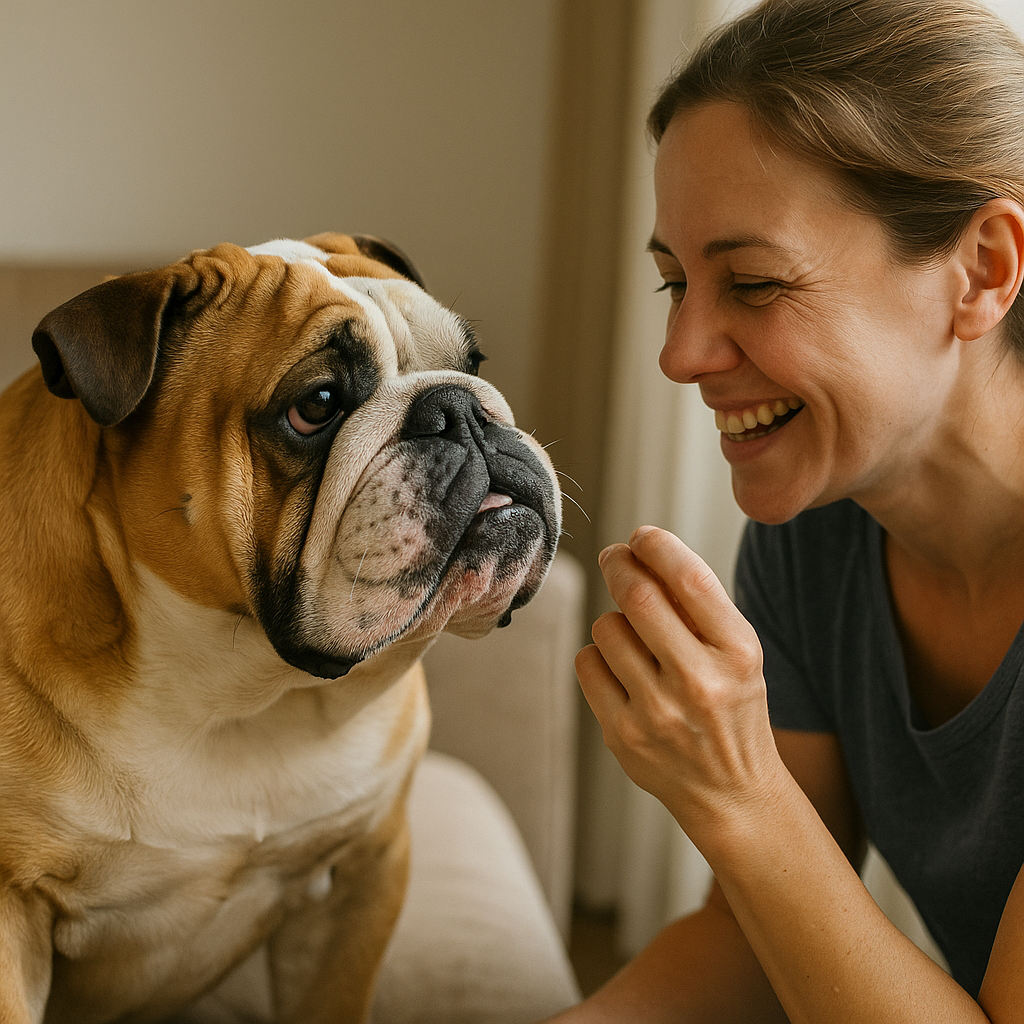The bulldog is a charming, loyal, and affectionate breed. However, it’s also known for being stubborn. Many owners face situations where their bulldog simply “decides” not to obey, ignores commands, or insists on doing things their own way. That strong personality can be challenging, but it doesn’t mean your bulldog is spoiled — it simply means they need a different, respectful approach.
In this article, you’ll learn how to positively manage bulldog stubbornness using training techniques based on respect, consistency, and positive reinforcement.
Understanding Bulldog Stubbornness
Bulldogs have a naturally independent personality. They’re not the type to follow orders without question. This stems from their history — they were originally bred for tasks that required courage and independent thinking, such as facing bulls. Over time, they became excellent companion dogs, but that behavioral legacy remains.
This means a bulldog doesn’t disobey out of defiance. They just like having control over their actions and won’t follow commands unless they see a reason to.
Be Patient: Results Come with Consistency
The key to dealing with stubbornness is patience. Bulldogs learn — and quite well — but at their own pace. Forcing or yelling doesn’t work. In fact, it can increase resistance and even break the trust between you and your dog.
Use a calm, unhurried approach. Repeat commands firmly but without aggression. Reward every small success and keep practicing daily, even if it’s just for a few minutes.
Always Use Positive Reinforcement
Positive reinforcement is the most effective tool for training any dog, especially a stubborn one. Instead of punishing mistakes, reward good behavior.
Effective rewards include:
- Tasty, healthy treats
- Cheerful verbal praise
- Petting and attention
- Playing with favorite toys
For example, if you want your bulldog to sit on command, hold a treat, say “sit” clearly, and as soon as they do, give the treat warmly. Repeat consistently and they’ll learn that obeying brings good things.
Establish a Predictable Routine
Bulldogs respond very well to routine. When they know what to expect — feeding time, walks, playtime — they’re more likely to cooperate. Predictability reduces anxiety and makes them more willing to engage.
Set fixed times for meals, walks, and training. This helps keep your dog mentally balanced and more open to following commands.
Avoid Direct Confrontations
If you try to force your bulldog to do something against their will, they may simply resist or freeze. This is common when pulling on the leash or trying to move them from a spot.
In these cases, redirect instead of forcing. Rather than yelling or pulling, show a toy, offer a treat, or change your tone of voice to something more upbeat. This encourages them to move by choice.
Be Clear with Commands
Avoid confusing your bulldog with long or inconsistent phrases. Always use the same words for the same commands and be direct.
Examples of clear commands:
- “Sit”
- “Stay”
- “Come”
- “Down”
- “No” (said firmly, not shouted)
Also, use a consistent tone of voice for commands and a warmer tone for praise. This helps your dog better understand what’s expected.
Train in Calm Environments
Bulldogs are easily distracted, so it’s best to start training in quiet environments, without other dogs, loud noises, or too many distractions.
Begin at home or in the yard, and only move to outdoor spaces once your dog is more responsive. Over time, they’ll learn to obey even in distracting situations.
Reinforce Good Behavior Daily
Don’t wait for formal training sessions to reward good behavior. Every time your bulldog does something right on their own — like sitting, waiting for food, or going potty in the right spot — praise and reward them.
These small daily gestures help shape behavior naturally and positively.
Respect Your Dog’s Limits
Just like people, each bulldog has their own personality. Some are more active and eager to train, while others are calm and reserved.
It’s important to respect your dog’s physical and emotional boundaries. If they’re tired, sick, or stressed, don’t insist. Wait for a better moment. Forcing training in the wrong situation will only slow progress.
When to Seek Professional Help
If your bulldog’s stubbornness is affecting your daily life, or if they show signs of aggression, fear, or high anxiety, it’s best to consult a positive reinforcement trainer or a veterinary behaviorist.
A professional can evaluate the situation and create a personalized training plan that respects your dog’s individual needs.
Conclusion: Firmness with Kindness Is the Best Path
Managing a bulldog’s stubbornness requires more understanding than force. This breed responds better to affection, respect, and repetition than to harsh commands. With patience, routine, and positive reinforcement, it’s entirely possible to shape their behavior and build a relationship based on trust and cooperation.
The secret lies in consistency, avoiding punishment, and always remembering that behind that stubborn little face is an intelligent and affectionate dog who just needs the right motivation to learn.
